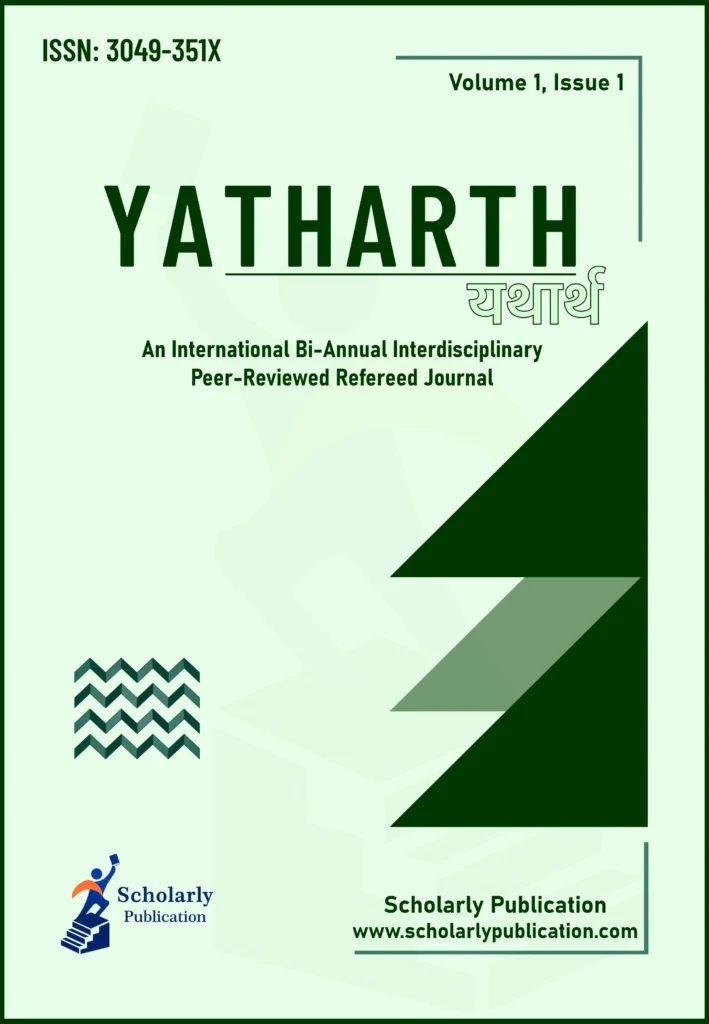Geography of Ramayana and the Importance of Raja Ram in National Unity and Security of Bhāratavarṣa
Volume 1, Issue 1, Article Number: 251006 (2025)
Home >> Yatharth >> Volume 1, Issue 1
Dr. Dheerendra Singh1,*
1Independent Research Scholar, India
*Corresponding Author: dhsingh2023@gmail.com
Received: 30 December 2024 | Revised: 01 February 2025
Accepted: 05 February 2025 | Published Online: 08 February 2025
DOI: https://doi.org/10.5281/zenodo.15106723
© 2025 The Authors, under a Creative Commons license, Published by Scholarly Publication
Abstract
This research paper presents a study of the role of King Ram in national unity and security by analysing the geographical places mentioned in Ramayana. The study of the geography of the Ramayana period is not only helpful in understanding the geographical structure of ancient India, but it also sheds light on the socio-political system of that time. Different places mentioned in Ramayana, such as Ayodhya, Prayag, Chitrakoot, Dandakaranya, Kishkindha, etc. exist today and their geographical locations correspond to the descriptions in Ramayana. The exile journey of King Ram was not only important from the geographic point of view as it extended from North India into South India, but it also helped to forge unity amongst different states and communities. It is evident in the research that King Ram formed diplomatic relations with several states during his journey. Alliances with Nishadraja Guha, Vanaraja Sugriva, and Vibhishana not only added strength in fighting against Ravana but also became an emblem of national unity. These relationships made by Ram transcended caste, religion, and regional boundaries, indicating his inclusive policy.
Ancient Indian geography is well illustrated, particularly by the rivers, mountains, and forests described in the Ramayana which depict natural boundaries and geographical diversities. Especially Dandakaranya, which extended across Madhya Pradesh, Chhattisgarh, and Maharashtra, gives an indication of the expanded forest area in ancient India. This work further elaborates on the strategic foresight of Ram in the context of national security. Successful campaigns against invaders such as Ravana not only reflect military prowess but also show his commitment to national security. This study seeks to present geography during the Ramayana era along with King Ram’s vision for nation-building in contemporary times. This study provides significant perspectives on national unity and national security for our times.
Keywords
Geography, Ramayana, National, Unity and Security
References
- Agnihotri, G.K. (2020). Rāma Aitihāsikatā Evaṃ Vanagamana Mārga. Radha Publication, New Delhi
- Arya, V. (2019). The Chronology of India: From Manu to Mahabharata. Aryabhata Publications, Hyderabad.
- Bhattacharya, R. (2023). Ram Rajya and contemporary governance. Indian Political Review, 28, 112-130.
- Mehrotra, S. (2016). Ram Utkarsh Ka Itihas. Lokbharti Prakashan, Allahabad.
- Mishra, J. (1986). Maryada Purushottam Bhagwan Ram: Jivan Aur Darshan. Lokbharti Prakashan, Allahabad.
- Poddar, V. (1980). Lord Rama – Ramayana Culture of India, Mahesh Poddar, Kolkata.
- Ravi, J. N. (2023). Geography of Ramayana: A Geographical Journey into the Rama Era. Notion Press, India.
- Shukla, R.K. (2003). The Geography of the Ramayana. Koshal Book Depot, New Delhi.
- Singh, J. P. (2014). India During Ramayana, South Asian Publishing, India.
- Valmiki. (2023). Ramayana. Gita Press, Gorakhpur.
- Pargiter, F. E. (1894). Art. VIII.—The Geography of Ráma’s Exile. Journal of the Royal Asiatic Society of Great Britain & Ireland, 26, 231-264.
[View Article] [Google Scholar]
- Rajagopalan, S. (2006). Security Idea in the Valmiki Ramayana. In Rajagopalan, S. (Eds.) Security and South Asia Ideas, Institutions and Initiatives, Routledge, New Delhi, 24-53.
Cite This Article
D. Singh, “Geography of Ramayana and the Importance of Raja Ram in National Unity and Security of Bhāratavarṣa,” Yatharth 1(1) (2025) 251006. https://doi.org/10.5281/zenodo.15106723
Rights & Permission
This is an open access article published under the Creative Commons Attribution (CC BY) International License, which allows unrestricted use, distribution, and reproduction in any medium, provided the original work is properly cited. No permission is needed to reuse this content under the terms of the license.
For uses not covered above, please contact the Scholarly Publication Rights Department.

